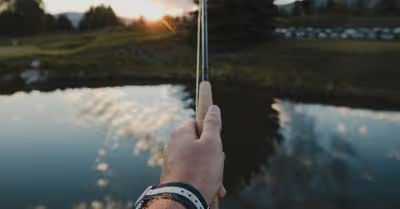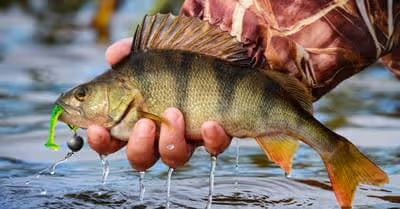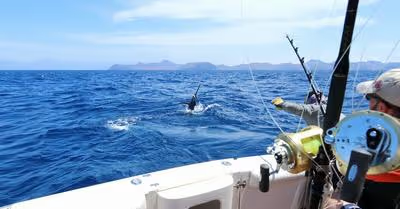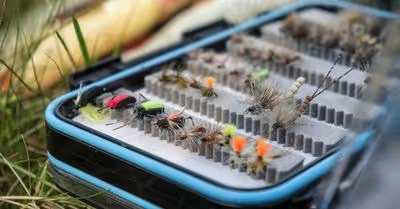Table of Contents
Fishing Rod Components
Being conversant with fishing rod components will make it much easier to exactly know what works best for you. Generally, these components are the same but may have insignificant differences based on the design of a fishing rod.
Handle
The handle is essentially the part of the fishing rod that you’ll be holding. Handles are typically made from EVA foam or cork or a combination of both to give you a comfortable and ultimate grip. Keep in mind that the handles may vary in length. So if you’re planning to cast longer, it would be advisable to go for a rod with a longer handle. This is because it enables you to get both hands involved if the catch is heavier. Differently, a rod with a shorter handle would be ideal if you want to cast in short distances or with one hand.
Other important but optional parts of the handle are the split grip and pistol grip handles. While split grips are popular with bass anglers, a pistol grip handle can help you keep the overall weight of the fishing rod to a minimum when making short casts or using lighter lures.
Reel Seat
This is not the one you sit in. Instead, this is what holds the reel to your rod. This is the area where you’ll slide the reel foot into the collars. It plays a crucial role in enabling you to have a better feel and to eradicate any play or shake on your reel. Make sure that you check out our article on how to choose a fishing reel and you’ll be good to go.
The best reel seats are made from graphite to give you a better feel. This material also makes them durable, which is important if you’re planning to fish in saltwater. On the contrary, cheaper rods have reel seats made from non-padded metal that can rust over time and that’s a bad thing.
The Blank and Guides
The blank is the main shaft portion of the fishing rod. You’ll find the guides located along the blank. These are loops or circular pieces that the fishing line is threaded through to give you more control. Guides are typically made from plastic, metal, and ceramic. Some are also plated with chrome to reduce line friction and abrasion.
Casting-style rods have guides facing towards the sky while spinning-style fishing rods have guides facing the ground.
Ferrules
Some rods are collapsible, meaning they can be broken into two. As such, you’ll have a male and female, which is the location where the two parts of the rod come together for better use. When connecting these two parts, it’s crucial to ensure that the above-described guides line up in the same line to give your fishing line a straight path to travel on.
Choosing the Rod Length
Now that you have a rod’s most important components at your fingertips, you can start looking at features that perfectly fit your fishing style. The length of a fishing rod can heavily influence your casting abilities. The length is typically calculated from the rod’s tip to the last part of the handle and can range from 4 feet to 14 feet. However, normal fishing rods measure between 6 and 8 feet.
When it comes to selecting the right length, it’s important to have in mind your fishing technique. In other words, shorter rods are appropriate if you want to cast in shorter distances while longer rods are meant for casting in longer distances.
The idea here is that a shorter rod is great for close combat where you don’t need a rod that has to bend more or stretch further, especially when you’re fighting a fish. You should, therefore, consider choosing a shorter rod if you’ll be fishing from a boat or in close range with the fish. Again, a shorter rod is perfect to fish in areas where your line is likely to be snagged such as in areas with woods, trees, and weeds. Differently, a longer rod (more than 8 feet) will be appropriate if you want to cast over a great distance and cover more water. They’re perfect for deep-sea fishing or if you are looking to cast from piers.
In essence, it’s important to consider your fishing environment as well as the type of fish you’ll be targeting when choosing the best length. All in all, you should go for a fishing rod measuring 7 feet if you’re a beginner and not sure of what works best for you. Well, this length will allow you to fish both at short and long distances as you hone your skills and experience.
Fishing Rod Materials
Many modern fishing rods are made from graphite or fiberglass. Experienced anglers typically prefer graphite rods because they’re stiff and powerful. They’re also very sensitive, which makes it a lot easier to detect when there’s a bite on your line. A major downside of graphite-made rods is that they are more fragile and so you should consider this.
Another popular option is rods made from fiberglass. Although they can be a little heavier, they’re very strong, durable, and require little maintenance. You can consider these types of rods if you’re looking to catch aggressive fish species such as pike and muskellunge. You can also go for rods that combine both graphite and fiberglass to give you the versatility required to fish for various species in various conditions.
Power and Action
Sometimes referred to as taper or weight, power is essentially the amount of force that you have to apply to bend the rod. A fishing rod with more power will be a lot easier to bend and is the ideal fishing rod.
In terms of action, this is principally the amount of bend that the rod has. Slow action rods will curve nearer to the handle to make them more flexible. These are great for lighter baits and fish. On the other hand, fast action rods will curve at the top third of the blank and are stiffer and are ideal for heavier baits and heavier fish species. There are also medium action rods that give you a combination of both worlds and are the most versatile.
Action and Power Ranges
- Ultra-light – Best for small fish species such as crappies
- Light – Perfect for panfish, bluegill, jacks, drums, and sunfish
- Medium-light – Great for walleyes, bass, and trout
- Medium – Ideal for catfish, bass, and redfish
- Medium-heavy – Perfect for snook, pike, salmon, and musky
- Heavy – Great for salmon, sturgeon, tuna, and tarpon
- Extra-heavy – Best for Shark, sailfish, halibut, and tuna.
Type of Fishing Rods to Choose
You now have an idea of the right length, power, and action that are perfect for your fishing rod. But that’s not all; you should choose the type of rod that’s ideal for your situation. They include:
Casting Rods – They have the guides on the top of the blank. This is to give you more accuracy when placing your casts. Baitcasting rods are more difficult to use for beginners as they can easily tangle the spool if you don’t handle them with care since their guide sizes are smaller, but are perfect if you want more precision on your line. Differently, spin-casting rods have bigger guides and are perfect if you’re a newbie but will not give you much accuracy or more control of your line.
Spinning Rods – They are smaller and lighter than casting rods. You should consider them is you’re planning on using a spinning reel. These types of rods have the guides on the lower side of the blank and are the easier-to-use options. This means that they’re perfect if you’re starting and looking for a lighter rod.
Surf Rod – These are ideal for surf fishing and are extremely long to allow you to cast in longer distances.
Overhead Rods – These are the perfect rods for boat fishing. They’re great for deep-sea fishing. All you have to do is drop your line and wait for the fish to bite.
Fly Rods – These are designed for fly fishing.
Kids Rods – These are of perfect weight and size for kids.
Conclusion
To this end, a fishing rod can either make or break your fishing adventure. Having the right rod will make you get the most out of your cast. If you’re a beginner, go for an all-round fishing rod measuring 7 feet, made of both graphite and fiberglass, and with a medium action until you’re comfortable enough to specialize**.**
Remember, a fishing rod will not necessarily make you a great angler but will enhance your chances of landing a big catch and will, of course, make fishing more enjoyable.
Recent Articles
















